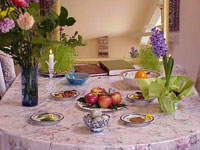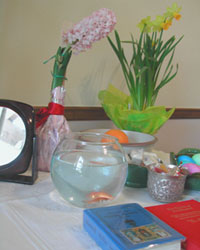Human Flower Project
Norooz – The Persian New Year
Spring in the Northern Hemisphere arrives today at 4:03 pm Tehran time.
 Haft Seen, with hyacinths
Haft Seen, with hyacinths
Image: Best Iran Travel
The vernal equinox, when days and nights are of equal length, marks the New Year or – Norooz—in Iran. This ancient occasion (it’s year 2564 by the Persian calendar) is recognized with a host of ceremonies and customs, all celebrating the freshness of “New Time” (No Ruz). Leaves poke out of bare branches. Maybe purity isn’t so puritanical, and “rebirth happens.”
“A few weeks before the New Year, Iranians clean and rearrange their homes. They make new clothes, bake pastries and germinate seeds as sign of renewal.” Of course, greenery and flowers appear during the NoRuz, especially the hyacinth or “sonbol.” This powerfully fragrant spring flower, native to Iran, appears on the Haft Seen set at this time.
“A special cover is spread on to the Persian carpet or on a table in every Persian household. This ceremonial table is called “cloth of seven dishes,” (Haft Seen) each one beginning with the Persian letter “cinn” (—or s). The number seven has been sacred in Iran since the ancient times, and the seven dishes stand for the seven angelic heralds of life—rebirth, health, happiness, prosperity, joy, patience, and beauty.”

Haft Seen, North Carolina, USA, 2001
Photo: Farsinet
As with American Christmas trees, every Haft Seen is different, but most will include the following objects:
1. sekeh – a gold, or shiny, coin symbolizing an adequate income
2. samanu – a sweet wheat pudding, symbolizing the sweetness of life
3. sabzi – green vegetable or herb shoots symbolizing fertility
4. sonbol – hyacinth flower
5. seer – garlic
6. senjed – a small dried fruit
7. serkeh – vinegar to ward off bitterness
If any of the items are not available, two other “s” items may be substituted: sib – apple, or sumagh – sumac.”
This site offers a closer look at the ritual items on the Haft Seen, their meanings and sacred origins.
 Haft Seen table
Haft Seen table
Austin, Texas, USA, 2003
Here in Austin, I was able two years ago to attend a Norooz celebration of local Zoroastrian families. Centuries ago, the Zoroastrians lived in Persia but after the advance of Islam, those who didn’t convert migrated to the Western coast of India. Quite a number of Zoroastrians have moved to the US in recent years.
There were about 15 families at this spring gathering, which included a fire, flower and prayer ceremony conducted by a Zoroastrian priest, and a delicious pitch-in meal. The Haft Seen table here was enlivened by both hyacinths and daffodils, a mirror, “sabze (a dish of sprouted grass), and a bowl of flashing goldfish.
(Astrologically, the first day of springs marks the end of Pisces, known in Persian tradition as the end of “the HOOT—large fish—period….This is the reason for placing an image of changing of the year on the New Year’s table.” )
Norooz festivities go on for nearly two weeks of feasting, visiting, and gift-giving. On the 13th day, known as Seezdah Bedar, Persian families bring the holiday to a close with a big meal out of doors. Also on this day, people throw out the dish of sprouted grass that has graced the Haft Seen. (Let’s hope those hyacinth bulbs are planted in the garden, to rebloom for Norooz 2565.)
Norooz Mobarak!!

